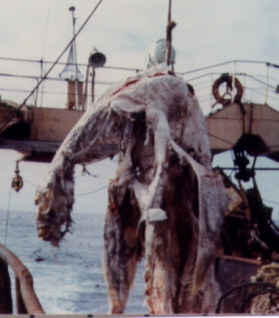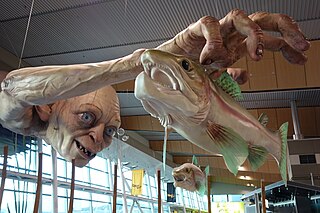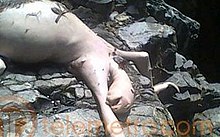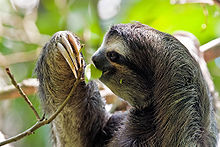
Bigfoot, also commonly referred to as Sasquatch, is a large and hairy human-like mythical creature alleged by some to inhabit forests in North America, particularly in the Pacific Northwest, despite scientific consensus. Bigfoot is an icon within the pseudoscience of cryptozoology, and an enduring topic within popular culture.

The chupacabra or chupacabras is a legendary creature in the folklore of parts of the Americas. The name comes from the animal's reported vampirism—the chupacabra is said to attack and drink the blood of livestock, including goats.

The Loch Ness Monster, affectionately known as Nessie, is a creature in Scottish folklore that is said to inhabit Loch Ness in the Scottish Highlands. It is often described as large, long-necked, and with one or more humps protruding from the water. Popular interest and belief in the creature has varied since it was brought to worldwide attention in 1933. Evidence of its existence is anecdotal with a number of disputed photographs and sonar readings.

A vampire is a mythical creature that subsists by feeding on the vital essence of the living. In European folklore, vampires are undead creatures that often visited loved ones and caused mischief or deaths in the neighbourhoods which they inhabited while they were alive. They wore shrouds and were often described as bloated and of ruddy or dark countenance, markedly different from today's gaunt, pale vampire which dates from the early 19th century. Vampiric entities have been recorded in cultures around the world; the term vampire was popularized in Western Europe after reports of an 18th-century mass hysteria of a pre-existing folk belief in Southeastern and Eastern Europe that in some cases resulted in corpses being staked and people being accused of vampirism. Local variants in Southeastern Europe were also known by different names, such as shtriga in Albania, vrykolakas in Greece and strigoi in Romania, cognate to Italian 'Strega', meaning Witch.

Sea monsters are beings from folklore believed to dwell in the sea and are often imagined to be of immense size. Marine monsters can take many forms, including sea dragons, sea serpents, or tentacled beasts. They can be slimy and scaly and are often pictured threatening ships or spouting jets of water. The definition of a "monster" is subjective; further, some sea monsters may have been based on scientifically accepted creatures, such as whales and types of giant and colossal squid.
Cadborosaurus, nicknamed Caddy by journalist Archie Wills, is a sea serpent in the folklore of regions of the Pacific Coast of North America. Its name is derived from Cadboro Bay in Greater Victoria, British Columbia, and the Greek root word "saurus" meaning lizard or reptile.

Trunko is the nickname for a large unidentified lump of flesh or a decomposed sea creature, a so-called "globster", reportedly sighted in Margate, South Africa on 25 October 1924. The initial source for Trunko was an article entitled "Fish Like A Polar Bear" published on 27 December 1924, edition of London's Daily Mail. The animal was reportedly first seen off the coast battling two killer whales, which fought the unusual creature for three hours. It used its tail to attack the whales and reportedly lifted itself out of the water by about 20 feet (6 m). One of the witnesses, South African farmer Hugh Ballance, described the animal as looking like a "giant polar bear" due to what was thought to be dense-white fur.

Walking with Dinosaurs is a 1999 six-part nature documentary television miniseries created by Tim Haines and produced by the BBC Studios Science Unit, the Discovery Channel and BBC Worldwide, in association with TV Asahi, ProSieben and France 3. Envisioned as the first "Natural History of Dinosaurs", Walking with Dinosaurs depicts dinosaurs and other Mesozoic animals as living animals in the style of a traditional nature documentary. The series first aired on the BBC in the United Kingdom in 1999 with narration by Kenneth Branagh. The series was subsequently aired in North America on the Discovery Channel in 2000, with Avery Brooks replacing Branagh.

A globster or blob is an unidentified organic mass that washes up on the shoreline of an ocean or other body of water. A globster is distinguished from a normal beached carcass by being hard to identify, at least by initial untrained observers, and by creating controversy as to its identity.

The Zuiyo-maru carcass was a corpse, caught by the Japanese fishing trawler Zuiyō Maru (瑞洋丸) off the coast of New Zealand in 1977. The carcass's peculiar appearance led to speculation that it might be the remains of a sea serpent or prehistoric plesiosaur.

Darren William Naish is a British vertebrate paleontologist, author and science communicator.

The Montauk Project: Experiments in Time by Preston B. Nichols and Peter Moon is the first book in a series detailing fictional time travel experiments at the Montauk Air Force Base at the eastern tip of Long Island as part of the Montauk Project.

Tecolutla is a town and municipality located on the Tecolutla River on the eastern coast of the state of Veracruz in Mexico. It has the closest beaches to Mexico City, and much of its economy is based on tourism, as it is only a four- or five-hour drive from the capital. It is the northern end of a tourist corridor along the Gulf of Mexico called the "Emerald Coast," which extends down to the city of Veracruz.
The Trout Lake Monster is an animal claimed to inhabit Big Trout Lake in northern Ontario. In 2010, photographs of an unidentified carcass prompted Internet speculation of a "mystery creature" and retellings of local First Nations legends of an animal said to presage bad news. According to a University of Toronto professor, the animal carcass was likely an ordinary mink in a state of decomposition.

Gollum is a fictional character in J. R. R. Tolkien's Middle-earth legendarium. He was introduced in the 1937 fantasy novel The Hobbit, and became important in its sequel, The Lord of the Rings. Gollum was a Stoor Hobbit of the River-folk who lived near the Gladden Fields. In The Lord of the Rings it is stated that he was originally known as Sméagol, corrupted by the One Ring, and later named Gollum after his habit of making "a horrible swallowing noise in his throat".
An orc, in J. R. R. Tolkien's Middle-earth fantasy fiction, is a race of humanoid monsters, which he also calls "goblin".

Cerro Azul is a mountainous part of Panama Province. There is a well marked road leading to Cerro Azul from the 24 de Diciembre town of the Panama District of Panama City. The mountains reach an altitude of 950 meters. Cerro Azul includes several villages including Rancho Cafe, Buena Vista, Las Vistas, Las Nubes and Los Altos. There is a lake on the main route to Cerro Azul where spectacled caimans have been spotted. The climate of Cerro Azul is pretty cool and it is a preferred weekend retreat for wealthy city dwellers wanting to escape the heat. Cerro Azul is an important poultry farming area, the Panamanian chicken and egg producer MELO has its production headquarters in Cerro Azul. Las Nubes and Los Altos de Cerro Azul have notable expatriate communities of mainly North American origin. Cerro Azul has gotten global media coverage after the "Cerro Azul monster" discovery.
Speculative evolution is a subgenre of science fiction and an artistic movement focused on hypothetical scenarios in the evolution of life, and a significant form of fictional biology. It is also known as speculative biology and it is referred to as speculative zoology in regards to hypothetical animals. Works incorporating speculative evolution may have entirely conceptual species that evolve on a planet other than Earth, or they may be an alternate history focused on an alternate evolution of terrestrial life. Speculative evolution is often considered hard science fiction because of its strong connection to and basis in science, particularly biology.

Creature suits are realistic costumes used to disguise a performer as an animal, monster, or other being. They are used in film, television, or as costumed characters in live events. Unlike mascots, they are often made with a high degree of realism. In contrast with prosthetic makeup, which is applied to an actor's skin, the wearer is not normally visible outside their movements controlling the costume, although in some cases, part of the wearer's body is still visible.

















